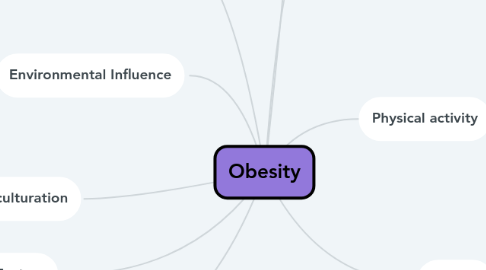Obesity
por Kostas Eleftheriadis


1. Environmental Influence
1.1. Obesogenic envinronment
1.1.1. Promotion of sedentary behaviour and easy access to energy dense food
1.2. Food availability
1.2.1. - Increased fast food outlets per unit area - Supermarkets all-year availability, open 24hr - Confectionary and snacks in DIY stores, vending, garages etc
1.3. Food type
1.3.1. Portion sizes
2. Acculturation
2.1. Perceptions about healthy BMI, weight size. Especially MEG Groups
3. Economic Factors
3.1. Affordability of fresh foods
3.2. Knowledge about nutrition
4. Education
4.1. Income
5. Medical Factors
5.1. Cushing's syndrome Hypothalamic tumours Hypothyroidism Hypogonadism Hypopituitarism Head injury
6. Pharmaceuticals
6.1. Corticosteroids Tricyclic antidepressants Valproate Sulphonylureas Insulin Some steroid contraceptives
7. Physical activity
7.1. due to less manual jobs and more technological advances
7.2. Children:
7.2.1. - Excessive TV and computer game time - Children are home alone (dual income parents) - Decreased physical activity at school and at home - Transportation by car or school bus - Neighborhood safety - Few public parks, sidewalks, swimming pools …etc.

